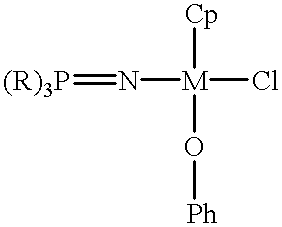Polymerization catalyst having a phosphinimine ligand
a technology of phosphinimine and polymerization catalyst, which is applied in the direction of catalyst activation/preparation, physical/chemical process catalyst, chemical/physical process, etc., can solve the problems of not revealing the polymerization of olefins, metallocene catalysts have shown limitations in their molecular weight capabilities and catalyst activity,
- Summary
- Abstract
- Description
- Claims
- Application Information
AI Technical Summary
Benefits of technology
Problems solved by technology
Method used
Image
Examples
example 1
Cyclopentadienyl titanium [(tri(t-butyl)phosphinimine)](2,6-diisopropylphenoxy) chloride was added to the reactor at 12.times.10.sup.-6 mol / l along with MMAO-7 (Akzo-Nobel) at Al / Ti=200 (mol / mol). The reaction temperature was 160.degree. C. and 2.1 gram / min of ethylene was continuously added to the reactor. An ethylene conversion of 91.6% was observed. The results of the experiment are set forth in Table 1 below.
example 2
Conditions were as in example 1 except that 13.times.10.sup.-6 mol / l of cyclopentadienyl titanium [(tri(t-butyl)phosphinimine)](2,6-diisopropylphenoxy) chloride was used along with 3 ml / min of 1-octene. An ethylene conversion of 88.8% was observed. The results of the experiment are set forth in Table 1 below.
PUM
| Property | Measurement | Unit |
|---|---|---|
| temperatures | aaaaa | aaaaa |
| molar ratio | aaaaa | aaaaa |
| temperatures | aaaaa | aaaaa |
Abstract
Description
Claims
Application Information
 Login to View More
Login to View More - R&D
- Intellectual Property
- Life Sciences
- Materials
- Tech Scout
- Unparalleled Data Quality
- Higher Quality Content
- 60% Fewer Hallucinations
Browse by: Latest US Patents, China's latest patents, Technical Efficacy Thesaurus, Application Domain, Technology Topic, Popular Technical Reports.
© 2025 PatSnap. All rights reserved.Legal|Privacy policy|Modern Slavery Act Transparency Statement|Sitemap|About US| Contact US: help@patsnap.com



